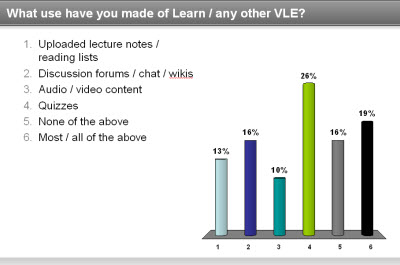Giving students the vote
A good example of a learning technology that’s gaining increasing favour on campus with academics and students alike is Electronic Voting Systems, otherwise known as Audience Response Systems or Clickers. Here at Loughborough we use the Turning Point system, which has the significant advantage of integration into Powerpoint which keeps the learning curve to a minimum.
 Here you can see a Turning Point / Powerpoint slide from a presentation I use in the New Lecturers’ Course. This slide is one of a group of 5 that I use at the beginning of my session to get a feel for the level of familiarity of the audience with e-learning. The audience simply click on the appropriate numbered button on the handset (see below) and when everyone has answered you close the polling and the graph of responses appears.
Here you can see a Turning Point / Powerpoint slide from a presentation I use in the New Lecturers’ Course. This slide is one of a group of 5 that I use at the beginning of my session to get a feel for the level of familiarity of the audience with e-learning. The audience simply click on the appropriate numbered button on the handset (see below) and when everyone has answered you close the polling and the graph of responses appears.
Once you become familiar with the system, there are a variety of question styles to try out, as well as the possibility of linking question slides. This can be useful where you’re looking for opinions rather than factual knowledge.
If you’d like to give Electronic Voting a try, the first thing to do is to download the Powerpoint plug-in from the Turning Technologies website at http://www.turningtechnologies.com/responsesystemsupport/downloads/ . This is a free download but if, like most staff, you don’t have admin rights to your PC, you’ll need to ask your IT support to install this. Once this is installed, you can then create new Turning Point interactive presentations or retrofit existing Powerpoints with voting slides. You’ll then need to  book the wireless ‘ResponseCard’ voting devices from Teaching Support, which you can do via the online equipment booking form at http://www.lboro.ac.uk/service/fm/services/ts/teaching-support.html . Note that for various reasons podium desktop PCs don’t have the Turning Point software installed so you’ll either need to book a laptop with Turning Point from Teaching Support or use your own. There are 300+ devices available, along with the USB ‘dongle’ that attaches to the lecturer’s PC. The devices available through Teaching Support communicate with the dongle via RF, unlike the cheaper alternatives which use infra-red with a much shorter range.
book the wireless ‘ResponseCard’ voting devices from Teaching Support, which you can do via the online equipment booking form at http://www.lboro.ac.uk/service/fm/services/ts/teaching-support.html . Note that for various reasons podium desktop PCs don’t have the Turning Point software installed so you’ll either need to book a laptop with Turning Point from Teaching Support or use your own. There are 300+ devices available, along with the USB ‘dongle’ that attaches to the lecturer’s PC. The devices available through Teaching Support communicate with the dongle via RF, unlike the cheaper alternatives which use infra-red with a much shorter range.
Teaching Support also have a number of text entry ResponseCards but these have proven problematic because they make it easy to post nonsensical or offensive messages anonymously; moreover, operation of these devices (unlike the standard model) is not particularly intuitive.
At Loughborough, to the best of my knowledge all use of electronic voting so far has been anonymous; that is, the devices are distributed randomly and responses are not tracked. However, this is happening in other institutions, and in some cases students are allocated their own personal ResponseCard on arrival. I’m aware of a couple of colleagues here who are proposing to try this. But for most people, one of the main benefits of the system is that students can engage with your questions without the risk of publicly ‘getting it wrong’.
A number of colleagues, such as Keith Pond (Business School) and Carol Robinson (MEC) have become very experienced users of Turning Point over the last few years, and have willingly shared their experiences through the Electronic Voting System Special Interest Group which Carol ran. I’ll be reconvening this group in the near future.